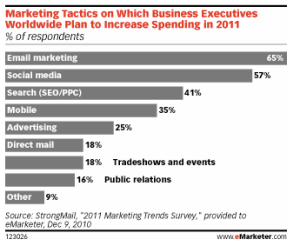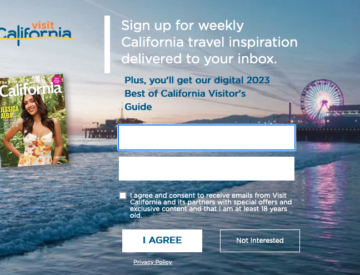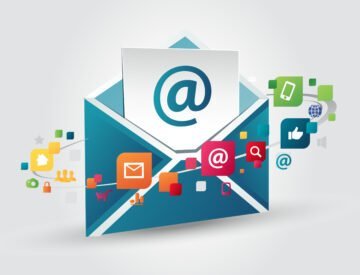In the past 18 months or so, I must have heard and read about a dozen articles signaling the demise of email marketing. In most cases, it may eventually be replaced by Facebook, Twitter or a mix of both. Having attended the Social Media Strategies in Travel conference in San Francisco in March 2010, I recall hearing the VP Marketing of an important Las Vegas hotel saying its property was achieving 3 times the ROI with Twitter push versus email blasts. It seemed as if email marketing was about to go down the path of the Dinosaur…
Perhaps you’ve even heard of Ben & Jerry’s decision to kill its monthly newsletter in the UK back in August 2010, in favor or Facebook and Twitter?
This is yet another case that shows that in marketing, it doesn’t always have to be either/or. Quite the contrary, in fact. There are now more media than ever to choose from, and marketers should have a strategic plan to decide which platforms have the best reach, efficiency and value in order to capture their target markets and clientele. TV, Radio, Print, Out-of-Home advertising, product placement, social media, email blasts, direct mail…
It may be only one, a combination or all of these options depending on your business model and budgets to reach your targets!
 In fact, a recent post on the Big Fat Marketing blog was aptly titled “Why Email and Social Media Should Be Friends”. It gave a few great example of brands combining both, such as Sobe, Baskin Robbins and Rue la la.
In fact, a recent post on the Big Fat Marketing blog was aptly titled “Why Email and Social Media Should Be Friends”. It gave a few great example of brands combining both, such as Sobe, Baskin Robbins and Rue la la.
Here are the top 3 reasons why email still has an edge over social media, and why they both ought to work closer together to achieve better results:
1. Email goes to your inbox
There are various key performance indicators to track the effectiveness of email campaigns, including open rates, click-through rates, sharing, unsubscribe rates, etc. But I believe the most important advantage with email remains the fact that until you delete the latest newsletter sent by your favorite ski resort, cruise line or hotel property, it shall remain in your inbox until you do so. Now you may receive that newsletter on a Tuesday morning, while at the office, and only have time to read it on Wednesday during your lunch break, as your catching up on voice mails and that ever-cluttered inbox. But from a marketer’s stand-point, I know it reached its intended target.
Meanwhile, depending on how many tweeps you follow on Twitter or people and brands you like on Facebook or Linkedin, you know how hard it is to keep track of messages on your home feed. Unless you glance regularly over your computer screen or smart phone, most messages will fly by and go unnoticed. By the way, have you ever tried to go back 24-48 hours in time to retrieve any given message? Unless you use aggregators such as Hootsuite, TweetDeck or Seismic to help you keep track of specific topics, it’s a daunting task.
2. Proprietary data
The other biggie is: who owns the data? An airline that owns a list of 500,000 clients, with permission to send email or direct mail to, is sitting on a gold mine, assuming it uses it right, i.e. don’t spam people every other day with repetitive offers! These are people that said yes, you can communicate with me. But if you have 70,000 people following you on Twitter and/or 100,000 fans on your Facebook page, well that’s fine and dandy until such day Mark Zuckerberg decides to pull the switch, or change the rules of engagement on Facebook. Twitter turned 5 years old last month, but will it still be around, or as dominant in another 5 years? Personally, I think so, but as a company, one needs to be cautious with who owns the customer data. Growing your own database of clients and permission-based email lists should remain a priority. Email marketing has been around for more than 15 years now, and while it has its flaws, it remains a powerful asset in any marketer’s toolkit.
3. Complementarity
Not-withstanding the above two points, I strongly believe email and Social Media complement each other. Using Facebook to get subscribers to your newsletter works as well as getting your newsletter readers to “like” a post from your blog, a picture on your Flickr account or a video hosted on your Youtube channel. All these platforms shouldn’t been seen in silos, but are rather part of your brand’s ecosystem on the web. A very good example of a company using these platforms together effectively is The Waffle House. They grew a proprietary database of 92,000 members for their monthly newsletter, and have had a presence on Facebook, Twitter and a corporate blog over the past year, using each platform to highlight the other.
In the hospitality business, email marketing has been around forever and the travel industry was one of the first to embrace social media for its potential to engage with clients, prospects and trade partners. But how well have we been combining both in order for the sum of the platforms to be superior to its parts? Do you know of any hospitality brands that have been successful in combining email marketing with social media? Please comment below, I’d love to hear more about them.









Leave a Reply